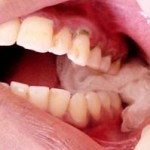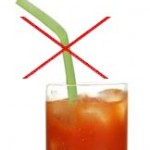After one or more teeth have been removed, you will want to do all the right things for the area to heal quickly and smoothly. This requires that a blood clot is formed. The blood clot covers the extraction site and allows the area to heal. A lot of the tips below help the blood clot to form properly and not become dislodged.
Do’s:
- Your dentist should let you know how to control any bleeding. Usually, a gauze pad will be placed on the area, and you should try and keep firm pressure on it. You should change this dressing about every 30 to 45 minutes, depending on the amount of bleeding. WARNING: Some people are freaked out by the amount of blood. Relax – a small amount of blood is mixed with a larger amount of saliva (or “spit†in dentist speak), which can make it look a lot more dramatic than it is! Many dentists will give you a package of gauze to take home with you, but you may want to buy some gauze beforehand. If you need to use it, fold the clean gauze into a pad, thick enough to bite on, then moisten it and place it directly on the extraction site. Hold the gauze firmly in place, by biting down on the pad or using finger pressure, for about half an hour to an hour. If this doesn’t stop the bleeding, moisten a tea bag with water and fold it in half and bite down on it for 30 minutes (the tannic acid in black tea helps stop bleeding). Some slight bleeding for the first day or so is normal. But if you still bleed more heavily after an hour or two, contact your dentist.
- While you shouldn’t rinse for the first 24 hours, after this initial period you should gently rinse 4 times a day using warm salt water (1 teaspoon of salt in a glass of warm water). Do not spit out forcefully! Rinse after every meal and snack, making sure that the water removes any bits of food around the area where the tooth is missing.
- Your dentist may also advise you to use chlorhexidine mouth rinse (Corsodyl in the UK, available in pharmacies, Peridex in the US, prescription-only) for 10 days or so following surgery. This kills bacteria.
- Be careful not to dislodge the blood clot when brushing near the extraction site for 3-4 days. You can carefully wipe the area with a clean, wet gauze pad. If you can’t get a toothbrush into your mouth due to swelling or discomfort (after wisdom tooth removal), chlorhexidine mouthwash (see above) is a handy adjunct.
- Stick to a liquid or soft food diet for the first day or two. Examples include soups, yoghurts, fruit milkshakes, smoothies, mashed potatoes, etc. A Vitamin C supplement may also be helpful. Avoid spicy foods, hot drinks and sodas for 3-4 days, to prevent irritation and burns.
- If you’ve been prescribed antibiotics, follow the instructions and make sure you finish the course.
- Swelling and sometimes bruising can occur after surgery, esp. with so-called “wisdom teeth†(short for wizzies). The worst swelling, pain and jaw stiffness normally occurs 2 or 3 days after surgery. On the day of the surgery, apply ice packs for 15 minutes on then 15 minutes off until bedtime. This will keep swelling to a minimum. Also keep your head elevated until bedtime. Moist heat after 36 hours may help jaw soreness. Arnica (a homeopathic treatment available from pharmacies and health stores) can be taken orally and/or as a cream to help with the swelling.
- After wizzie removal, try to gently keep stretching your mouth open to get it moving again. It can be tempting just to not open it wide at all, but that can lead to permanent limitated opening (“trismusâ€). Don’t overdo it, though!
- If you can get hold of it in time, chlorine dioxide gel is great for post-op healing after extractions and anything which might leave your gums a bit sore. It’s also great for oral ulcers and burns. Unfortunately, it’s not sold in shops, so unless your dentist sells it, Oxyfresh Dental Gel is only available by mail order.
Don’ts:
- Don’t be tempted to rinse the area for 24 hours after tooth removal.
- Avoid hot food or drinks until the numbing wears off. You cannot feel pain while you’re numb and may burn your mouth. Also take care not to accidentally chew your cheek!
- Don’t poke at the extraction site! – keep your fingers and tongue away from this area.
- Avoid sucking (through straws and stuff), spitting, and blowing your nose (unless you have to). This is because positive or negative pressure could dislodge the blood clot. If you have a cold or allergies or anything that will want you blow your nose or sneeze, take appropriate medications to treat these.
- Try not to smoke for as long as possible afterwards, but at the very least for the rest of the day. Smoking can interfere with the healing process, and also the sucking motion could dislodge the blood clot.
- Avoid alcohol for 24 hours, as it could delay the healing process.


